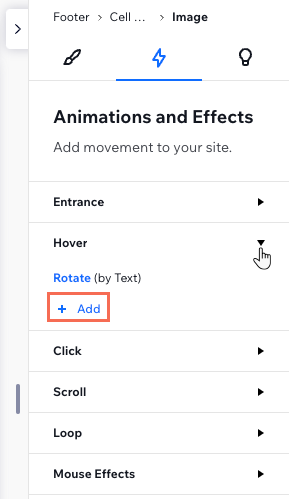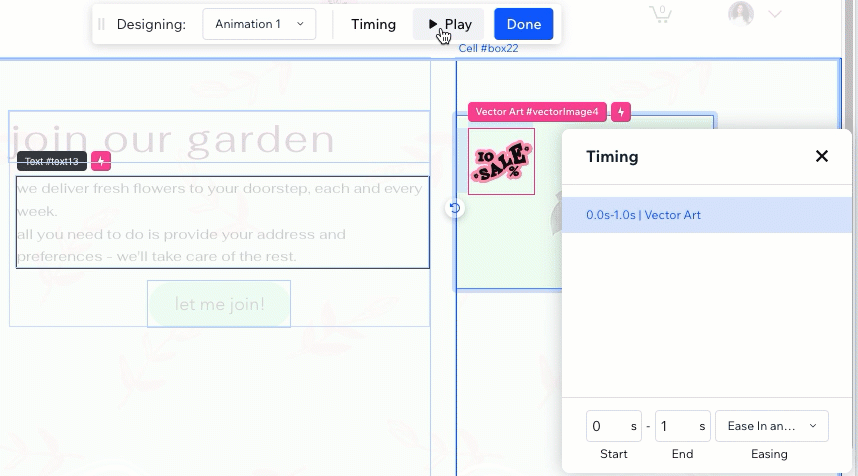
wix studio
Creating a Custom Click or Hover Interaction
Add interactions to create an animated experience as visitors click or hover over elements. The interaction can animate the same element that triggered it, or any other element on the page.
With custom interactions, you have full creative freedom to design an animation from scratch. You can also control the animation's timing to make it truly effective.
Go to our Wix Studio Academy to check out additional Wix Studio webinars, tutorials, and courses.
Step 1 | Add a trigger (click or hover)
To get started, select the element that triggers the interaction. This is the element that visitors hover over or click before seeing the animation. Then, go to the Inspector panel to add a new interaction.
Tip:
You can add multiple interactions to an element so it triggers different animations on hover or click.
To add a trigger:
Select the element that should trigger the interaction.
Click the Open Inspector icon
 at the top right of the editor.
at the top right of the editor.

Click the Animations and Effects tab
 .
.Select Hover / Click.
Click + Add.

Step 2 | Set up the interaction
You can now choose which element gets animated, the animation that should appear and the exact action that happens on hover or click (e.g., apply the animation, toggle it on / off, etc.)
To set up the interaction:
(In the Setup panel) Select an option from the On Hover / On Click drop-down:Start Animation: Clicking / Hovering over the element triggers the chosen animation.
Toggle On/Off: Similar to a toggle, clicking the element triggers the animation and a second click removes it.
Reset Animation: Clicking / Hovering over the element removes any animation that was previously applied.
Select an option from the Animated element drop-down:Make the element trigger its own animation: Click the element's name (the word (self) appears next to it).
Animate a different element on the page: Select an element from the drop-down, or click Choose on Canvas to select it on the page.
Tip: Hold the Cmd / Ctrl key to select a child element.
Click the Custom tab.
Click Create Custom Animation.
Tip:
Custom animations that you create are saved for future use on other elements.

Step 3 | Customize the animation
Now it's time to build the animation from scratch. Add all kinds of layout and design transforms to change the element's size (Scale), position (Translate), angle (Rotate), fill color and more.
You can also design the element's initial state to complement the animation you built. This is how the element looks when it loads, before visitors interact with it. To tie it all together, set the animation's duration and ease.
To customize the animation:
Choose how you want to customize the animation:
Adjust the element's design
Adjust the relevant settings in the Inspector panel to create the custom animation:
Opacity: Change the opacity of the element by entering a value lower than 100%.
Rotate: Make the element rotate in a certain direction by entering an angle in the text box.
Scale: Make the element shrink or grow. You can enter the same value in both X (width) and Y (height) so that the element resizes in its original proportion.
Skew: Make the element turn sideways. Enter a value for the width (X) and the height (Y) of the element.
Translate: Move an element right/left (X) or up/down (Y) by adjusting the X and Y values.
Fill color & opacity: Choose a different color and opacity for the element's background.
Apply glass effect: Enable a frosted glass effect on the element's background.
Corners: Make the element's corners sharper or rounder.
Border: Add a border to frame the element.
Shadow: Add shadow behind the element.
Note: The available settings vary based on the element you choose to animate.
Design the element's initial state
Click the Designing drop-down on the floating bar.
Select Initial state.

Adjust the relevant settings in the Inspector panel.
When ready, click Done.
Set the animation's duration and ease
Set the duration and ease in the Timing panel:
Start and End: Set the duration of the animation (in seconds) using these fields. The Start field also controls the delay of this animation.
Easing: Choose how the animation eases in and out.
Closed the Timing panel?
You can always re-open it by clicking Timing on the floating bar.
2. (Optional) Click  Play on the floating bar to preview the animation.
Play on the floating bar to preview the animation.
3. When ready, click Done.

Tip:
When setting an element to show on click or hover, it appears with a checkered overlay on the canvas. This is to indicate that the element is initially transparent.

You can turn this indication off at any time. Click the Wix Studio icon  , hover over View and click Transparent Elements.
, hover over View and click Transparent Elements.
FAQs
Click below to learn more about creating interactions.
How does it look when an element triggers its own animation?
In the example below, hovering over the title animates it. The title skews and changes its color.

How does an interaction between different elements look?
In the example below, hovering over the text box animates the image right next to it.

Can one element trigger multiple other elements?
Yes, but not in a single interaction.
You need to create a separate interaction for each element you want to animate, even if they should all be triggered by the same element.
In the example below, we created 3 different hover interactions for the same text element. When visitors hover over the text, it animates an image, a button and another text element – all at the same time.

Can a single element have multiple animations?
When an element triggers its own animation (self), you can combine one hover interaction, one click interaction, and an entrance animation.
Using a custom animation, you can apply multiple transforms to the same element, so they all appear in a single interaction.
In the example below, we created a custom hover interaction for the title. When hovering over the title, it skews and changes its color at the same time.
